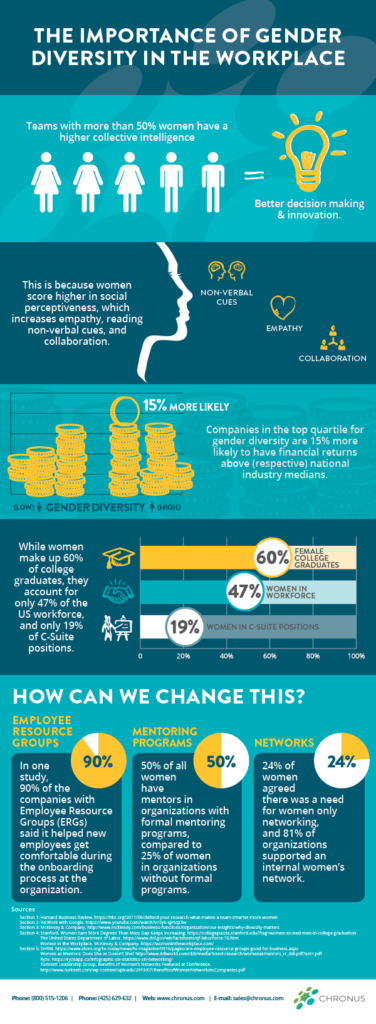From pay disparities to imbalanced leadership roles, the conversation around increasing gender diversity has reached the core of workplace dialogues. While strides towards inclusivity are admirable, gender diversity remains more an aspiration than a reality in many industries.
Why does gender diversity matter, and what are its tangible benefits in the workplace? This comprehensive article tackles these questions head-on and offers insights for companies eager to inject diversity into their organizational DNA.
What is Gender Diversity?
Gender diversity involves the fair representation of different genders. It encompasses creating a workplace culture where individuals are valued for their unique characters regardless of their gender identity or expression. Gender diversity in the workplace is not about fulfilling a quota; it’s about embracing the variety of skills, perspectives and experiences people of different genders bring to the table.
What is Gender Parity?
Gender parity takes the gender diversity concept further, advocating for equal participation, pay, and treatment of all genders. Within the workplace, gender parity also addresses systemic barriers that may prevent certain genders from advancing in their careers or being represented in leadership positions.
Why Does Gender Diversity Matter in the Workplace?
A robust study by McKinsey & Company found companies in the “top quartile for gender diversity are 15% more likely to have financial returns above their respective national industry medians.” It’s not just a statistical advantage; it’s a competitive edge that separates forward-thinking companies from the pack.
Additionally, a report by PwC noted that 85% of female millennials look for employers with a strong track record regarding diversity. The study also found female millennials decided whether or not to work for an employer based on their policy around diversity, equality, and workforce inclusion. Thus, gender diversity isn’t just a virtue; it’s a performance strategy.
How Does Gender Disparity Impact Women Employees in the Workplace?
Conversely, gender disparity can be lethal when representing moral and economic risks. When half of the potential workforce is systematically hindered due to gender, there’s a clear detriment to the company’s talent pool, innovation, and financial prowess. On the employee level, women often face challenges in getting hired, promoted and earn less compared to their male counterparts.
Furthermore, gender biases in the workplace have strongly affected women employees, especially underrepresented women employees, contributing to the long-standing “broken rung” in the corporate ladder. The broken rung refers to a broken step at the bottom of the corporate ladder, indicating barriers women face when advancing in the company at the first step of management. Studies show that there is a 75% drop in representation of women of color between the entry-level and the C-suite.
What Can Companies Do to Include a Diverse Set of Genders?
The playbook for instilling gender diversity in the workplace isn’t shrouded in mystery; it’s in thoughtful planning and execution. From establishing inclusive recruitment practices and fostering an environment that champions equal pay and opportunities to adopting diversity training programs, mentorship initiatives and flexible working arrangements, there’s a spectrum of actions available to catalyze change.
Building the Foundation for Gender Diversity in the Workplace
In the pursuit of gender diversity, certain foundational elements stand as pillars of success:
- Transparent Hiring Practices: It’s not enough to say you want diversity; you have to show it, starting with inclusive job descriptions and working your way through the hiring and promotion process.
- Fair Compensation: The gender pay gap is a reality that businesses need to face head-on. Transparent compensation policies based on skill and performance, not gender, will level the playing field.
- Emphasis on Advancement: When a workplace is designed with gender diversity in mind, promotion decisions are made based on merit, negating any gender influence.
- Safe Work Environment: Minimizing toxic work environments and reducing issues of harassment create a safe space where women can work without fear of reprisal or unfair judgment.
How Do Companies Benefit from Hiring More Women Employees?
Establishing gender diversity in the workplace isn’t just a checkbox on a corporate to-do list. When companies actively recruit and hire women employees, it’s an investment in the company’s future.
Economic Prosperity
Inciting the bottom line is where gender diversity speaks volumes. Research from the International Labour Organization found that on a global scale, 60% of companies with a gender-diverse workforce reported an increase in profits and productivity, with 57% of company respondents agreeing that gender diversity initiatives significantly improve business outcomes. More female representation means more profitable endeavors and the numbers don’t lie.
Wider Talent Pool
Diversity leads to a richer talent pool – and a happier one. Women comprise half of our global population and, therefore, offer half of the world’s intellectual capital. They also make up a majority of the population (56%) currently enrolled in college or graduate school. By tapping into this pool, companies can leverage a broader range of skills, ideas, and vantage points to elevate the company above competitors. Not doing so could mean missing out on the next big idea, the groundbreaking innovation, or the game-changing product.
Happier Employees
A Glassdoor survey found that 67% of job seekers consider diversity a crucial factor when evaluating companies and job offers. By prioritizing gender diversity in the workplace, companies attract top-tier talent and create a more positive working environment. Happier employees mean lower turnover rates, which, in turn, translates to savings on recruitment, onboarding, and training costs.
How Can Companies Benefit from Advancing Female Employees in the Workplace?
Studies show that women are recruited and hired at a lower rate than men. However, a more significant disparity occurs regarding promotions and opportunities for advancement. It’s here that companies can capitalize on gender diversity.
Diverse Leadership Pipeline
Companies need to build and nurture a diverse leadership pipeline. When women see other women in leadership roles, it provides them with tangible role models and evidence of the potential within the company. This, in turn, encourages retention and ambition among current employees and attracts other qualified women to join the team.
Increased Innovation and Creativity
Gender diversity fosters innovation by bringing together different perspectives and experiences. Women have been found to approach problem-solving in a more collaborative and inclusive manner.
Studies show that teams with more than 50% women have a higher collective intelligence, leading to positive outcomes like better decision-making and innovation. Gender diversity offers transformative benefits and could very well be the secret sauce to propelling companies into new markets and pushing the envelope on existing products and services.
Better Representation of Customers and Stakeholders
A one-size-fits-all approach is no longer viable in today’s contemporary business landscape. Companies with diverse teams are better equipped to understand and cater to an equally diverse customer base. Additionally, having a voice at the table representing each stakeholder ensures that the company’s decisions are well-rounded and resonate with all those affected.
Supporting Gender Diversity with Women Programs
Institutionalization of gender diversity through women-specific programs in the workplace is critical to sustained progress and promoting a culture where women can thrive:
- Employee Resource Groups (ERGs) to Support Women Employees: ERGs provide a safe space for women to share their experiences, challenges, and successes with others who can relate. It’s a network that boxes out isolation and fuels kinships that can reinforce courage and mutual support.
- Women Mentoring Programs: Formal mentoring programs tailored to women can increase confidence, job satisfaction, and a deeper sense of belonging within the organization.
Mentorship Programs: A Retention Strategy for Women
Women mentorship programs can become a powerful tool for retaining female talent. The benefits of such programs extend beyond the individuals involved to impact the organizational culture as a whole:
- Opportunity to Network with Others: Mentorship programs provide women with networking opportunities that can be otherwise difficult to foster, given societal and professional restrictions.
- Knowledge Sharing Among Colleagues: Mentees in mentorship programs often gain a wealth of knowledge, including skill development from their mentors. Mentees also have the opportunity to increase their knowledge in a mentorship program by networking with not just their mentor but with other mentees and colleagues.
- Accelerated Professional Development: With the guidance of experienced mentors, women can sharpen their skills and tackle new challenges, accelerating their career progression and leadership development.
- Inclusive Workplace Culture: As organizations build women mentorship programs, they signal a clear commitment to fostering a culture of equality and inclusion, implicitly boosting morale and retention.
Innovating with Employee Resource Groups
Employee Resource Groups provide women within an organization with a unique platform where they can connect, develop, and contribute to the business. These groups are not just about networking but about creating a community and support system.
- Professional Development: Through ERGs, women can access a wide array of professional development resources, including training, seminars and workshops.
- Workplace Flexibility: ERGs can help organizations understand and implement workplace policies that accommodate the diverse needs and schedules of female employees, promoting work-life balance and overall satisfaction.
- Advocate for Change: ERGs can be powerful advocates for gender diversity in the workplace by providing collective voices on important issues and influencing organizational policies.
Conclusion: Driving the Gender Diversity Agenda
Gender diversity in the workplace is more than a trend or an obligatory HR checkbox; it’s an existential imperative for companies aiming to thrive in an increasingly complex and competitive market. By acknowledging the challenges and taking proactive steps toward gender parity, companies not only do the right thing but also set a series of events in motion that lead to a stronger and more successful future.
Whether through equitable HR practices, an inclusive workplace culture, or investing in female leadership development, the opportunities are vast. As we stride into a new era of work, the companies that champion diversity will write a different kind of success story – one where all genders shine equally and the workplace thrives in the light of untold potential.
Are you ready to join the ranks of the gender-diverse workforce? Start today by evaluating your company’s diversity and inclusion initiatives and acknowledging what you can do to improve. Encouraging workplace mentorship programs and ERGs through platforms like Chronus can be a powerful step toward fostering the growth and development of all employees, regardless of gender.
Remember, the true measure of diversity isn’t in the statistics – it’s in the lives and opportunities it impacts.




